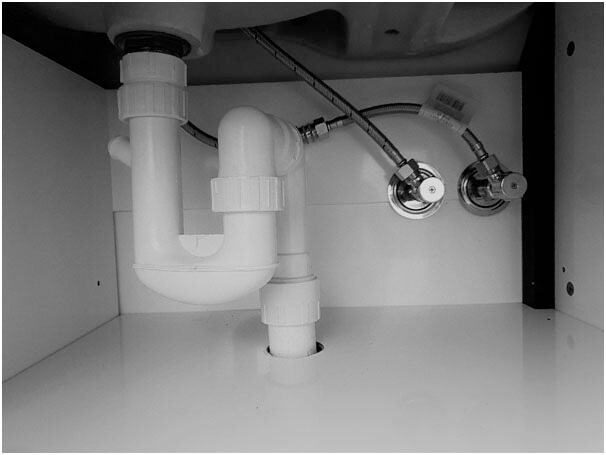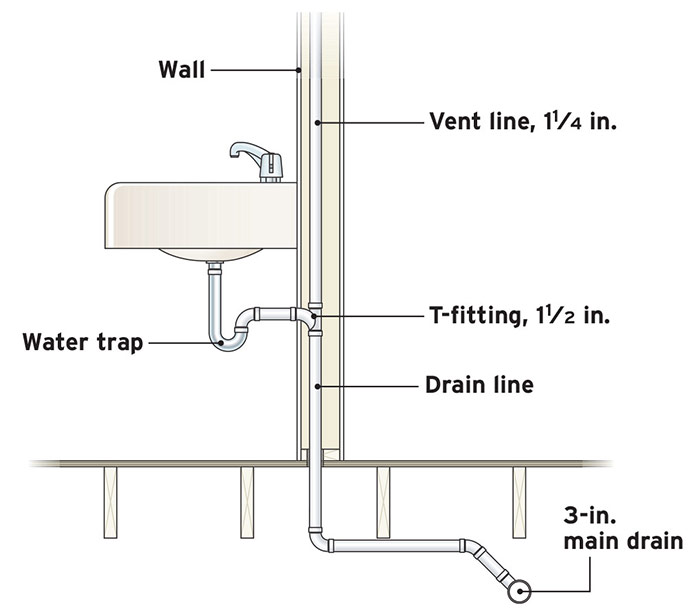We've discovered this article on The Upsides of Proper Ventilation in Plumbing Design listed below on the web and concluded it made good sense to relate it with you on this site.

Appropriate ventilation in plumbing systems is commonly neglected, yet it is vital for preserving the functionality and safety of your home's pipes. Ventilation helps manage air pressure, stop the build-up of dangerous gases, and make certain the efficient elimination of waste. In this guide, we will explore the significance of correct pipes air flow, just how it works, and the benefits it gives your pipes system.
Recognizing Ventilation in Plumbing
Ventilation in plumbing refers to the network of pipes that allow air to flow with the water drainage system. These vents offer multiple objectives, including controling atmospheric pressure within the pipelines, protecting against sewage system gases from going into the home, and assisting in the smooth flow of wastewater.
Exactly How Air Flow Works in Pipes Solutions
Air Pressure Policy
Proper ventilation keeps balanced atmospheric pressure within the pipes system. When water streams via pipes, it displaces air. Without appropriate ventilation, this displacement can create adverse pressure, leading to slow drains pipes or siphoning of water from catches, which can create undesirable smells to permeate right into the home.
Protecting Against Sewer Gas Buildup
One of the most crucial functions of plumbing vents is to stop drain gases, such as methane and hydrogen sulfide, from accumulating within the home. These gases can position severe health and wellness threats and are extremely combustible. Vent pipelines allow these gases to escape safely outdoors.
Helping in Waste Elimination
Air flow assists in the reliable removal of wastewater by protecting against airlocks in the drainage system. When air can stream easily with the vents, it permits water and waste to move efficiently via the pipelines, reducing the threat of blockages and backups.
Sorts Of Pipes Vents
Key Heap Vent
The major stack air vent, additionally referred to as the vent stack, is the key vent in a pipes system. It extends from the primary drainpipe line up through the roofing system, enabling gases to run away and fresh air to get in the system.
Branch Vent
Branch vents link to the main stack air vent and serve specific components, such as sinks, bathrooms, and showers. These vents guarantee that each fixture has appropriate ventilation to work correctly.
Air Admission Valve (AAV).
An Air Admittance Valve (AAV) is a one-way shutoff that allows air to enter the plumbing system without the demand for a conventional air vent pipe expanding through the roofing system. AAVs are frequently made use of in remodellings or locations where mounting a basic vent is not practical.
Indicators of Poor Air Flow in Plumbing.
Slow Draining Fixtures.
If your sinks, tubs, or bathrooms are draining pipes slowly, maybe an indication of poor air flow. Insufficient air flow can produce a vacuum cleaner impact, making it tough for water to drain appropriately.
Gurgling Seems.
Gurgling noises originating from drains are frequently a result of air being sucked with water catches as a result of unfavorable stress in the pipes. This is a clear indicator of not enough air flow.
Unpleasant Odors.
Drain odors inside your home are a red flag that your pipes system is not appropriately ventilated. This might indicate that sewer gases are not being properly vented outside, resulting in potentially dangerous problems.
Typical Ventilation Blunders.
Poor Vent Sizing.
Utilizing undersized air vent pipes can lead to inadequate air flow and stress discrepancies in the system. It's necessary to make use of vents that fulfill the specific requirements of your pipes system.
Improper Vent Positioning.
Positioning vents also much from the fixtures they serve can lower their efficiency. Proper placement makes sure that air can move openly and effectively via the system.
Disregarding Code Needs.
Building ordinance offer certain standards for pipes air flow. Neglecting these codes can cause a system that falls short to operate correctly and may result in costly fixings or carcinogen.
Advantages of Appropriate Air Flow.
Improved System Performance.
Correctly ventilated pipes systems run much more successfully, with less clogs, faster draining, and much less stress on the pipes. This performance extends the life expectancy of the plumbing system.
Improved Air Quality.
By avoiding sewer gases from entering your home, correct air flow contributes to better interior air top quality, making your living atmosphere healthier and a lot more comfy.
Avoiding Water Damages.
Sufficient air flow assists prevent water from being siphoned out of catches, which can lead to drain gases getting in the home and creating water damage in time.
Actions to Ensure Appropriate Air Flow.
Consulting Plumbing Codes.
Always get in touch with regional pipes codes when making or modifying your plumbing system. These codes give the required standards for correct venting and ensure your system satisfies safety and security requirements.
Routine Inspection and Maintenance.
Routine assessments can help recognize prospective ventilation issues before they come to be major problems. Upkeep jobs, such as cleaning up air vent pipelines and looking for clogs, are important for maintaining the system in good working order.
Professional Setup.
For new setups or major adjustments, it's wise to employ a specialist plumber. They have the competence to ensure the ventilation system is properly developed and installed according to code.
Verdict.
Proper air flow is a crucial part of any kind of pipes system, making sure that it works efficiently and securely. By recognizing the relevance of ventilation, recognizing the signs of poor air flow, and taking steps to keep your system, you can protect against costly problems and protect your home's air top quality.
4 Things You Should Know About Your Plumbing Vents
What Plumbing Vents Are
Also called a vent stack, a plumbing vent is a vertical pipe attached to your drain line that runs through your roof. The plumbing vent pipe, or plumbing air vent, removes gas and odors from your plumbing system and allows fresh air to enter the pipes, helping the water to flow out of the drain pipes.
What Plumbing Vents Do
Plumbing vents have two basic functions. One of which is to allow unpleasant smelling wastewater and sewer gasses to escape your plumbing system instead of entering your home. Plumbing vent pipes are typically located on roofs, away from windows, to ensure the fumes exit the home completely.
The other function of the plumbing vent is to move fresh air into your plumbing system. This helps move water through every plumbing fixture in your house, like toilets and sink drains. Think of the way in which you need to let a little air into the bottle as you pour soda in order to make the drink flow smoothly.
Different Types of Plumbing Vents
True vent: This is the most common vent option. In simplest terms, a true vent is a vertical pipe attached to your drain line that exits through the roof. They often function as the main vent that other fixtures can connect to. Re-vent pipe or auxiliary vent: Attached to the drain line near specific plumbing fixtures, re-vent pipes run up and over to connect to the main vent. Common vent: Two plumbing fixtures installed on opposite sides of a wall are typically tied into the vent stack using something known as a sanitary cross. Wet vent: This venting option operates as a drain pipe and a vent at the same time. Wet vent drainage systems drain water from one fixture while venting the air from another. Although they’ve been used for over 100 years, wet vent systems have only recently been added to the plumbing code in many areas. If you’re planning on installing one in a bathroom remodel, make sure you check your local code prior to construction. Loop vent: For free-standing fixtures like kitchen island sinks, loop vents are ideal. These vent pipes run under the floor, rise from the P-trap, and create a loop inside the cabinet sink. Air admittance valve: An AAV is a one-way mechanical valve typically installed at the site of the plumbing fixture. AAVs allow venting to occur without having to tie into a larger venting system. They’re ideal for venting fixtures where you aren’t able to easily connect to an existing vent system. Common Plumbing Vent Issues
Although vent pipes typically don’t have water flowing through them, they’re still subject to many typical plumbing issues. For example, clogs are one of the most common problems associated with sewer vent pipes. If your vent pipe gets clogged, all of your plumbing fixtures tied into the vent stack will be affected.
A sink with a slow drain that bubbles and gurgles or a strong sewage smell around your toilet are both indicators that your toilet vent pipe is clogged. Because most vent pipes exit through the roof, old leaves, twigs or even a bird’s nest could be clogging the pipe.
Clogs in your vent pipe system cause a buildup of negative pressure, meaning that water won’t be able to flow out of your home very well. It’s similar to putting your finger over the opening of a straw to trap water inside. When you remove your finger, the water is able to flow out of the straw.
If you suspect you have any blockage in your vent, make sure you have a professional come examine the situation. Left unchecked, a blocked air vent can lead to other costly repairs, like leaks and sediment buildup.
Under Pressure
Pipe vents are essential aspects of a home’s plumbing system. Owning a home means learning about all sorts of things you never put much thought into before. But by understanding as much as you can about the important systems of your home, you can keep those budgets intact and those anxiety levels low.
https://www.homeserve.com/en-us/blog/home-improvement/plumbing-vents/

I ran across that review about while surfing around the internet. Loved our posting? Please quickly share it. Let other people discover it. Thanks a lot for going through it.
Estimating